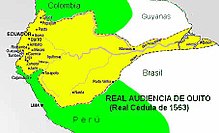Real Audiencia de Quito
The Real Audiencia de Quito (dt. Royal Audience of Quito ) was from 1563 on a judicial district ( Real Audiencia ) of the Viceroyalty of Peru . When the Viceroyalty of New Granada was separated from Peru briefly in 1717 and finally in 1739 , the Real Ausiencia was added to it and belonged to it until the end of the colonial period in 1822. The congruent administrative unit was called Presidencia de Quito , it was also called Province of Quito ( Provincia de Quito ). The highest sovereignty was the (court) president and captain general. The territory corresponded in large parts to today's Ecuador , of which it was the colonial forerunner, as well as areas that today belong to Peru and Colombia, especially in the Amazon basin . The Real Audiencia de Quito bordered the Real Audiencia of Lima to the south and the Real Audiencia of Santa Fe de Bogotá to the north .
history
The Real Audiencia was founded in 1563 with its seat in Quito and took the place of the governorship established in 1533 (span. Gobernación ). In 1592 the "sales tax revolution " (span. Revolución de las alcabalas ) took place in Quito, which was supported by the Mestizo community in Quito, which was already of considerable size and had its own sense of identity. On this basis, they protested against the administrative practices of the Spaniards, which they regarded as abuse, and against the group of newcomers ( chapetones ) who they hated .
The Real Audiencia was part of the economic system of the Viceroyalty of Peru, which mainly supplied mining products to Spain. She assumed the role of textile producer . In addition to spinning and weaving, agriculture and, within its framework, sheep breeding were important. The port of Guayaquil was one of the most important shipyards in America in the 17th century. It experienced a slow decline since the 18th century, on the one hand because new trade routes did not pass Guayaquil, on the other hand due to tax increases and other political measures to consolidate the treasury in Madrid, which were also at the expense of the colonies. The Real Audiencia and especially the northern Andean region around Quito, in particular, hit the commercial monopolies in Spain hard, as they cut off their export opportunities, especially in the textile sector, and caused the closure of many wool weaving mills in which the region specialized.
From a cultural point of view, the Quito school of sculpture and painting should be emphasized, which gained importance in the 17th and 18th centuries mainly through the sacred art of the painter Miguel de Santiago and the sculptors Bernardo Legarda and Caspicara .
The Real Audiencia de Quito was abolished on May 25, 1822 after the royal troops were defeated in the decisive Battle of the Pichincha against the independence fighters under Antonio José de Sucre .
President of the Real Audiencia
- Hernando de Santillán (1563–1571)
- Lope Díez de Armendáriz (1571–1574)
- Pedro Gracía de Valverde (1574–1578)
- Diego de Narváez (1578–1581)
- Manuel Barros de San Millán (1587–1593)
- Esteban Marañón (1593-1599)
- Miguel de Ibarra (1600–1608)
- Juan Fernández de Recalde (1609-1612)
- Antonio de Morga (1615-1624-1627-1636)
- Alonso Pérez de Salazar (1637–1642)
- Juan de Lizaraza (1642-1645)
- Martín de Arriola (1645–1652)
- Pedro Vásquez de Velasco (1655–1661)
- Antonio Fernández de Heredia (1662–1665)
- Diego del Corro Carrascal (1670–1673)
- Lope Antonio de Munive (1678–1689)
- Mateo de la Mata Ponce de León (1691–1703)
- Francisco López Dicastillo (1703–1705)
- Juan de Sosaya (1707-1714)
- Santiago Larraín (1715-1718 and 1722-1728)
- 1718-1722 repeal of the Real Audiencia
- Dionisio de Alceda (1728-1736)
- José de Araujo (1736–1745)
- Fernando Sánchez de Orellana (1745–1753)
- Juan Pío de Montúfar (1753–1761)
- José Diguja (1767–1778)
- José García de León (1778–1784)
- José de Villalengua (1784–1790)
- Antonio Mon y Velarde (1790-1791)
- Luis Muñoz de Guzmán (1791–1798)
- Luis Héctor de Carondelet (1799–1807)
- Manuel de Urriez, Count Ruiz de Castilla (1807–1809)
- Supreme Junta (1809, President: Juan Pío Montúfar )
- Manuel de Urriez, Count Ruiz de Castilla (1809–1811)
- Sovereign Junta (1811-1812, President: José Cuero y Caicedo )
- Toribio Montes (1812-1817)
- Juan Ramírez de Orosco (1817-1819)
- Melchor Aymerich (1819-1821)
- Juan de la Cruz Mourgeon y Achet (1821-1822)
- Melchor Aymerich (1822)
literature
- Ekkehard Keeding: The Age of Enlightenment in the Province of Quito . Böhlau Verlag, Cologne / Vienna 1983 (= Latin American research 12), ISBN 3-412-01083-9 .
- Federica Morelli: Un neosincretismo político. Representación política y sociedad indígena durante el primer liberalismo hispanoamericano. El caso de la Audiencia de Quito (1813-1830) . In: Thomas Krüggeler, Ulrich Mücke (eds.): Muchas Hispanoaméricas. Antropología, historia y enfoques culturales en los estudios latinoamericanistas . Vervuert, Frankfurt am Main 2001, ISBN 3-89354-129-2 , pp. 151-165.



